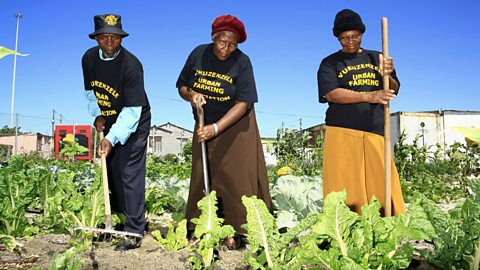Case studies in Africa - increasing food supply
Some places have put measures in place to increase food supplies.
Case study: large scale agricultural development
Spain is a high income country (HIC) in Europe. The country is one of the largest producers of fruits and vegetables globally. Since the 1980s, the southern region of Almeria has been home to the largest concentration of greenhouses in the world. Food such as tomatoes, cucumbers and peppers can be grown year-round within the greenhouses. The site covers around 40,000 hectares and is so big that it can be seen from spaceÔÇï.
Kilombero Plantations Limited (KPL) run a 5,818 hectare farm in the Kilombero Valley, where they grow rice crops. They process and store the rice on site and they use machinery like tractors, planters and combine harvesters. KPL grow 35,000 tonnes of rice, which is more than anyone else in East Africa.
Advantages
- Almeria produces around 3.5 million tons of fruits and vegetables each year.
- Produce from the greenhouses is estimated to be worth between Ôé¼1.2 and Ôé¼3 billion, bringing in money for the local economy.
- Tens of thousands of workers are employed within the site.
Disadvantages
- Many of the greenhouses are made of plastic. Each year, the greenhouses generate an estimated 33,500 tonnes of plastic waste.
- The greenhouses use more water than can be supplied by local rainfall. Some of the additional water comes from deep wells underground, and some has to be brought in from the mountains.
- Reports suggest that workers often work without contracts, are paid below the minimum wage and are exposed to dangerous pesticides.
Local case study: urban farming in Cape Town, South Africa
South Africa is a middle income country (MIC)A country (as classified by the World Bank) having a gross national income per capita of US$1,026 to $12,475, eg Botswana. (MIC) in Africa. Cape Town is the legislationThe passing of laws. capital of the country. Cape Town has many townshipLess-developed settlement on the edge of cities in South Africa., which are less developed settlements found on the edge of the city. food securityWhen people have enough nutritious and affordable food to eat. has been a problem in the townships, with around 35% of households experiencing hunger. urban farmingThe growing of crops in and around towns and cities. is a recent initiative, whereby residents grow food on patches of land near where they live or work. The scheme is sustainable, in that local people have control over decisions, and the initiative is manageable.

Advantages
- Levels of health have improved as people are eating more nutritious food.
- Urban farms help to reduce food miles, which is good for the environment.
- Unemployed residents now have an income.
Disadvantages
- Crops are irrigated with domestic wastewater and this can contain bacteriaSingle-celled microorganisms, some of which are pathogenic in humans, animals and plants. Singular is bacterium. and virusAn ultramicroscopic infectious non-cellular organism that can replicate inside the cells of living hosts, with negative consequences.. This spreads disease.
- On many occasions, urban farmers do not receive training. This can create pollution through overuse of fertiliserA nutrient added to the soil to increase the soil fertility. and pesticideA chemical used to kill pests, such as the potato cyst nematode which is a pest that destroys potato crops..
- The success of the urban farming initiative in Cape Town may have discouraged the government from tackling issues of food security at a national level. Urban farming is seen as a solution, when the problems are in fact much greater.